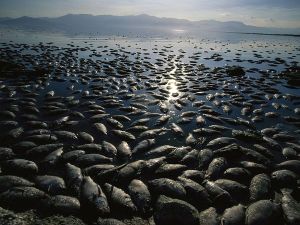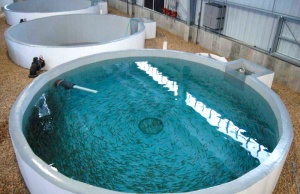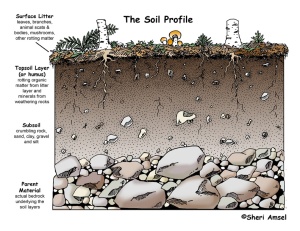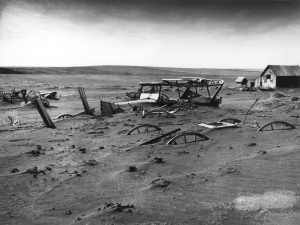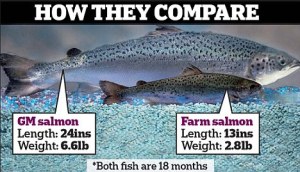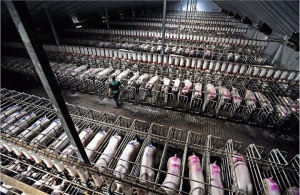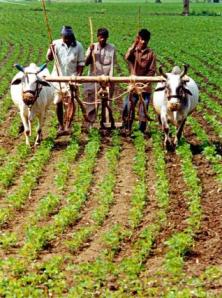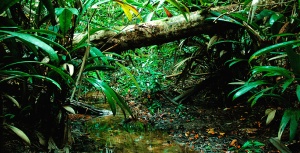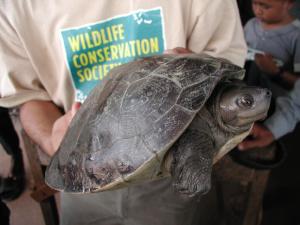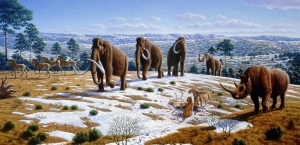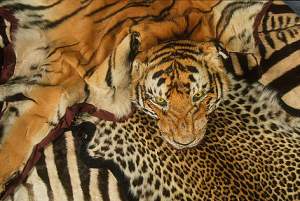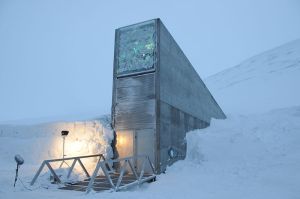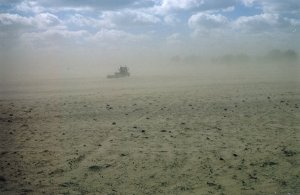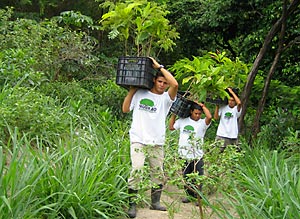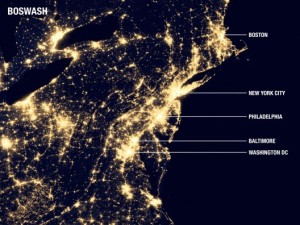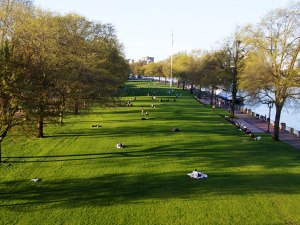The struggle for finding food has been one that has followed humans since the dawn of the farming societies. For thousands of years food that was raised, fished or farmed was extremely difficult to find to feed the entire human population with times of plenty broken up by famine, a severe shortage of food in an area which can result in mass starvation, deaths, economic chaos and social disruption. Although we have gone through a green revolution, a time period in which global food production increased because of technological advances, irrigation, manufacturing inorganic chemical fertilizers and pesticides, developing high-yield varieties and more. The up side of this is that many more people are being fed than before, yet in the long-term, the over-catches of fish as well as the industrialized method of farming that is now heavily employed leads to unsustainable soil health and marine ecosystems in the future.
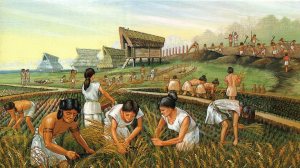
Hunter-gatherer and farming societies were around for thousands of years before the green revolution created industrial agriculture.
The methods of fishing and means of raising livestock and growing produce that are employed now may seem to provide enough for the time being but in order to feed all humans into the future there needs to be introduced the idea of organic farming as well as more raising fish via aquaculture without the depletion of stocks of fish that are now available.
Some who hold the Environmental Wisdom viewpoint and also advocate for animal rights may state outright that animals should not be raised for human consumption for ethical reasons. It is true that the traditional system of industrial agriculture is questionably ethical in its handling of farm animals. Many are forced to live their whole lives in strictly small and restrictive pens where animals like chickens, pigs and cows are crammed in. The main goal of industrial agriculture is to provide maximum output with minimal input and this is a product of that. In the case of this treatment, organic agriculture is the simple solution.
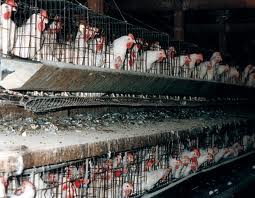
An example of a factory farm that crams chickens into small living quarters, an ethically questionable practice.
The problems found in aquatic ecosystems are numerous but mainly are connected to the same problems that are found with general declines in terrestrial biodiversity. These include habitat loss, invasive species, pollution, climate change and over exploitation.
When we trawl the oceans with reckless abandon, taking gigantic submerged nets with huge chains and steel plates and completely destroying the sea floor habitat for a few species that can be sold on the market, we are fishing unsustainably.

Trawling of the seafloor is one practice that severely depletes the biodiversity of aquatic ecosystems.
Invasive species are another danger to aquatic ecosystems, as evidenced by the accidental introduction of the lion fish into the Caribbean. As excellent predators they flourish in the east coast of North America, out-competing native species to the point of their extinction.
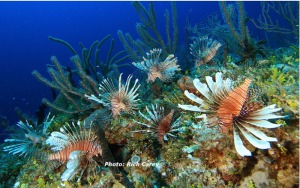
Lion Fish have invaded the North East Atlantic off of the coast of Florida and other states, unfortunately out-competing native species.
As we examined in a previous entry, human overpopulation has many unforeseen problems associated with it, and directly influences aquatic life in a negative way. Despite the simple overcrowding of oceans by means of boating, humans have accidentally allowed agricultural nitrogen runoff into the waters of many oceans, causing eutrophication leading to algal blooms, fish die-offs and a general degradation of ecosystem services. This nitrogen runoff is connected to the unsustainable system of industrialized agriculture we will discuss later, which we will see must be changed. Toxic pollutants are also extremely detrimental to the marine habitats, as are plastics that threaten the lives of millions of marine animals.
We also affect the aquatic ecosystems that sustain us by overfishing wild species of fish. Modern methods of fishing have caused as much as an 80% depletion of some wild fish species in 10-15 years with the modern fleets now on the water. Trawler fishing (mentioned earlier) severely degrades the ocean bottom as well as catching many wild fish species that are not easily re-established. In addition, these methods are unsustainable because they not only capture the fish that are going to market but also bycatch, or fish that is unwanted.
Many believe that overfishing is simply done out of necessity to feed the growing number of humans, however there are alternatives that will maintain the wild populations of fish and also keep the world fed. Aquaculture, or fish farming, is a better way to maintain supplies of fish for the human population and still keep aquatic ecosystems filled with a wide variety of wild fishes. To save many of the losses that are associated with trawling and more, consumers can use their dollars to purchase sustainably caught or farmed fish. There is even an app powered by the Monterey Aquarium to help you make sustainable choices. Yet again, the power to change many of these policies is in the hands of the consumers, as mentioned in an earlier post.
Some believe we should simply cease obtaining our food from the ocean, they reflect a viewpoint akin to the Environmental Wisdom viewpoint. However, I believe the number of people who require the sustenance of fish is overwhelming-especially with the constraints of overpopulation. A more obtainable goal is managing the fisheries by way of reducing our coastal activities as well as preventing overfishing by way of aquaculture. This reflects the Stewardship viewpoint, or the idea that you can care for both the earth and humanity when making sustainable decisions.
Policy-wise, many bills have been passed to protect the wild species in oceans and freshwater bodies of water. As mentioned previously CITES, a bill that was implemented to help endangered species, is also used to look after marine life. The 1979 Global Treaty on Migratory Species was also passed, as well as the U.S. Marine Mammal Protection Act of 1972, the U.S. Endangered Species Act of 1973, among others were all passed in order to protect aquatic biodiversity. The difficulty with implementing many of these policies is that the ocean is considered a commons of the world’s countries, and is thus trickier to police. But with luck these policies, in conjunction with the bottom-up support of aquaculture and sustainable fishing, will help the oceans recover.
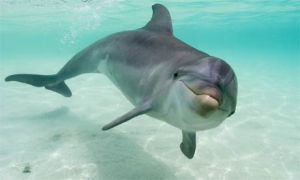
The Bottlenose Dolphin is an example of one species protected by the Global Treaty on Migratory Species.
Despite the great contribution by fisheries, most food is actually produced on land by industrialized, modern means. In general, this implies that synthetic fertilizers, chemical pesticides, genetically modified seeds, antibiotics and a significant amount of fossil fuels are used in the farming and raising of food.
Although the recent increase in technological advances to increase output while reducing lost crops seems to have increased the number of people that can be fed per square acre of land, the new methods are unsustainable in that they degrade the soil over the course of months and years as well as being unsustainable to the rest of the environment. Much of the time irresponsible farming practices cause salinization, desertification, and erosion of the soil. Because soil takes thousands of years to build, as bedrock needs to be eroded to create the substrate and leaf litter and other organic materials must decompose, the fact that soil is being degraded at a faster rate than it can be made is a bad sign.
One example of an intense period of soil erosion was the midwest in the 1930’s. The Dust Bowl, as it was later named, happened when much of the topsoil under the sod was lost from a combination of cultivation practices and drought threatening to turn the Great Plains into a desert. Plowing in the conventional way tore up the roots of natural grasses, and the crops that settlers planted had shallower roots that did not prevent erosion. Once a drought hit, the area was a dead zone.
Looking back, the catastrophic consequences may have been avoided had the farmers looked at the land and adapted their practices to the landscape. Today’s organic agriculture takes into account the natural processes of the land by looking towards sustaining the soil, and thus maintaining a healthy ecosystem, rather than plowing the fields blindly looking for maximum yield
The fossil fuel emissions from tractors and trucking of the food is quite immense, but also adding in the amount produced by farm animals such as cows that release methane gas, the amount increases.

Cow flatuation contributes more CO2 emissions to the atmosphere than many would think, mainly due to the diet of grains that they are fed in industrial agriculture
With the rampant use of pesticides and synthetic fertilizers in the fields, as well as feedlots, or acre large areas of land without any natural scrub or grass to raise animals, there comes the eutrophication of bodies of water. Many times fish are killed by the deoxygenation of large swathes of nitrogen that runoff from these feedlots, as well as the toxic pesticides.
Even human health is affected by industrialized agriculture, as nitrates and pesticide residue in drinking water cause ill health effects. Wastes from the huge feedlots can be found in places they aren’t meant to. E. Coli outbreaks are a prime example of the trouble with the mismanagement of animal wastes.

A graphic explaining the outbreaks of E. Coli in Germany. The bacteria, originating in the guts of cows, is found in produce when feedlot waste contaminates irrigation water.
A new technological advancement in the form of genetically modified organisms have been begun to be harvested for numerous reasons. They require less fertilizers and water, and are more resistant to disease, frost and drought as well as grow faster. However, many believe the disadvantages outweigh the benefits.
In general, the genetically modified organisms may have unpredictable genetic and ecological effects. Much of the worry with GMO’s has to do with the precautionary principle because, untested, we do not know the consequences of these organisms interacting with the environment. Also, there is no proof that they have even created a higher yield since they have been introduced. And because they are perfectly engineered they may also out-compete other wild strains of crop and lower genetic diversity outside of the farm.
Genetic diversity for seeds is actually extremely important as even if sickness kills of one strain, other strains will survive. In essence, though GMO’s are huge advancements in the field of science, they may not be the miracle cure-all that is needed to feed us all.
All of this natural capital degradation is the main reason why organic farming has been turned to in the past couple of decades. Organic agriculture involves crops grown without the use of synthetic pesticides, fertilizers, or using genetically engineered seeds and animals, and synthetic growth hormones. What is better about organic agriculture is that the main goal is to prevent soil erosion and the use of synthetic fertilizers and sewage sludge to raise crops. Instead, animal manure and compost is used to maintain the health of the soil. Crop rotation is a practice used that gives the soil time to rest, in place of involving a slash and burn method of growing crops which gradually wastes it away, and is used in organic agriculture. Organic Agriculture’s other aims are to reduce fossil fuel usage and increase the usage of renewable energy such as solar and wind on farms.
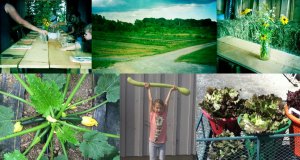
9 Miles East is an organic farm in Schuylerville, NY which stands by its pledge to “improve the soil every year.”
Generally, organic farms are local and thus involve less fossil fuel input in order to deliver produce from one area to another. The practice of industrialized agriculture of globally exporting food from all corners of the globe has brought a bounty of new and exciting produce to many people, but on the flip side it does carry with it the problems of increased fossil fuel usage and more greenhouse gasses.
To address the ethical conundrum of industrial agriculture, organic agriculture provides a solution. Animals are given more land to live on, and thus are labelled as free range, as they were supposed to-grazing land that has scrub grass and a diverse ecosystem. Waste from organic farms is not a worry and in fact helps maintain the grazing land that animals live on.
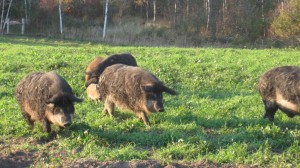
An Organic pig farm, with heritage breed free range pigs. Also a point of recent scandal with the state of Michigan, which is attempting to label all free range hogs as feral
Many claim that organic agriculture is better for human health as well, as there are no pesticides or hormones found in the produce that could have negative effects on the health of the consumers. Various health problems that arose from the overuse of these chemicals can be avoided by farming organically.
Subsistence farming in extremely poor countries reflects that past viewpoint, as poverty is the sheer motivation for poor farming practices in those countries. Polyculture, in which numerous crops are grown on land instead of one crop, can be done as well as high-yield hydroponics, which avoids the use of soil altogether. As we have seen before, poverty creates many problems within environmentalism. Working the land in a more sustainable way will lead to the overall healthiness of the soil, although there may be large short-term price tag.
Overall, what we can come away with is that with thinking towards a more sustainable agriculture, there are solutions to the environmental problems we face today. Organic agriculture is a ready example of a system two decades in the making that can change the way we look at food. In addition, although aquaculture only provides 7% of the food produced, that number can rise to help maintain the proper diversity of wild fish species to balance the aquatic ecosystems and the oceans, the lifeblood of Earth.
